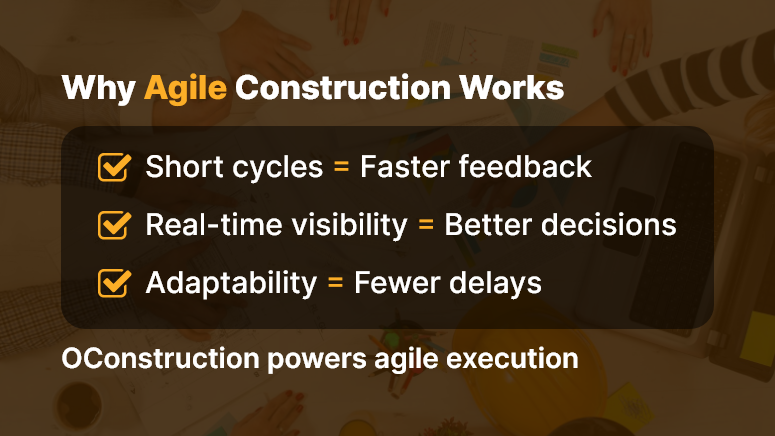Studies show that nearly 60% of construction projects miss deadlines due to rigid planning and poor adaptability. Enter agile construction management, a flexible approach that allows teams to pivot quickly and deliver value in short cycles.
But is it a good fit for your projects? If you’re a project manager, site lead, or operations executive, this topic matters because today’s clients expect faster response times and adaptive delivery.
In this article, we’ll define agile construction management, reveal when it works best, and show how OConstruction’s integrated platform supports it — with real examples and actionable strategies. By the end, you’ll know if agile approaches can boost your productivity and project success.
Business Relevance & Why It Matters
Construction traditionally follows a linear model: design, then build, then deliver. This often leads to delays, inflexibility, and cost overrun when changes occur.
However, agile construction management shifts this model by using shorter work cycles, regular stakeholder feedback, and responsive adjustments. Companies that adopt agile methods gain faster iterations and clearer visibility.
They also reduce risk by proactively handling unforeseen obstacles.
Who benefits most?
- Commercial builders are facing frequent change orders
- Infrastructure firms need to coordinate phased deliveries
- Developers managing multi-stakeholder expectations
Use case #1: A mixed‑use developer experiences zoning shifts mid‑project. Agile sprints help respond quickly.
Use case #2: A renovation contractor works in inhabited buildings requiring frequent stakeholder input. Agile cycles reduce disruption.
Use case #3: A large civil contractor coordinates utility installation in small increments. Agile milestones allow phased deliveries.
Clearly, the pain point — rigid planning, coordination delays, and change orders — contrasts sharply with agile flexibility, faster decision‑making, and stakeholder collaboration.
With OConstruction’s platform, you implement agile construction management effectively: schedule sprints, track progress, collect feedback, and adjust using a centralized dashboard.

Best Practices, Frameworks & Actionable Strategies
1. Do’s and Don’ts for Agile Construction
- Do start with short planning cycles (1–2 weeks) to review tasks and adjust priorities. This enhances responsiveness.
- Don’t overload sprints with too many concurrent tasks. It reduces focus and slows delivery.
- Do hold regular stand‑ups onsite to align teams and surface issues early.
- Don’t ignore stakeholder feedback between cycles—it leads to misalignment and rework.
2. Quick Wins & Best Practices
- Start with a pilot project
Choose a smaller project to test agile workflows. This provides early lessons and builds confidence.
- Break tasks into smaller deliverables
Divide work into manageable chunks—like permitting, foundation, framing. Then deliver and evaluate incrementally.
- Set clear performance metrics per sprint
Track issues closed, tasks completed, or customer feedback responses. Use data to refine the next cycle.
3. Step‑by‑Step Framework Using OConstruction
- Step 1: Define sprint durations and assign tasks using the digital kanban board.
- Step 2: Log daily progress through mobile updates; sync team status in real time.
- Step 3: Hold weekly sprint reviews using built-in collaboration tools and comment threads.
- Step 4: Collect feedback from site leads, clients, and subcontractors using digital forms.
- Step 5: Adjust task priorities and resource allocation for the next sprint directly in the platform.
This agile framework ties back to agile construction management and leverages OConstruction’s integrated features — task tracking, mobile updates, feedback collection, and sprint analytics — to maintain momentum and clarity throughout the delivery process.
Customer Story/Use Case Example
For example, Skyline Builders, a mid‑sized residential contractor, adopted agile construction management using OConstruction’s sprint‑based task board and mobile progress tracking. They launched a pilot for a four‑unit condo project. As a result:
- They reduced rework by 30% through faster feedback loops
- They delivered critical tasks 20% faster by real‑time task reprioritization
- They improved subcontractor coordination and on‑site communication
Here’s how: Skyline created two‑week sprints, used mobile inputs for daily updates, and collected feedback directly in the platform from the client and team members.
Each cycle ended with a short review meeting and sprint backlog adjustment. This approach delivered clearer visibility, faster adaptation, and more predictable outcomes.
Key Takeaways & Closing Summary
Agile construction management can drive significant improvements in flexibility, stakeholder alignment, and delivery speed — especially when you use the right platform. With OConstruction, you gain:
- Sprint‑based planning and transparent task tracking
- Real‑time updates via mobile and dashboard views
- Integrated feedback loops that reduce rework and miscommunication
By embracing agile methods thoughtfully, construction firms can mitigate delays, improve coordination, and increase customer satisfaction.
Ultimately, using agile construction management with an integrated tool like OConstruction transforms project execution into a flexible, responsive workflow that adapts to changes and delivers consistent value.
